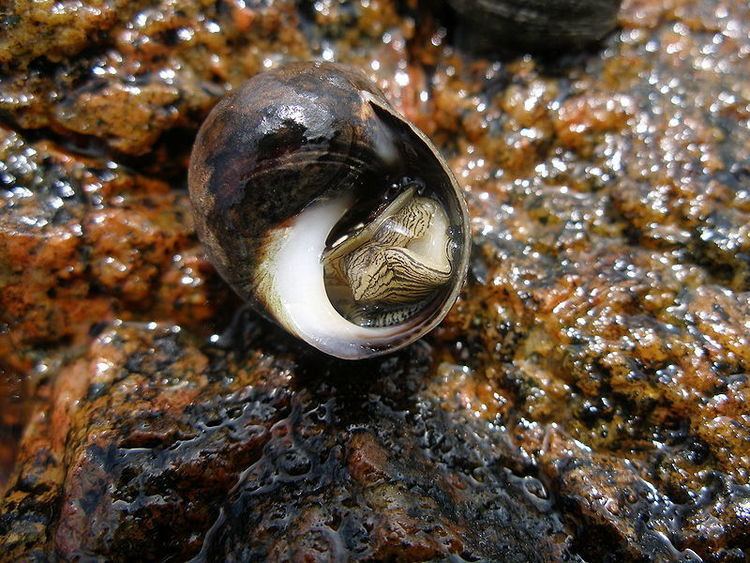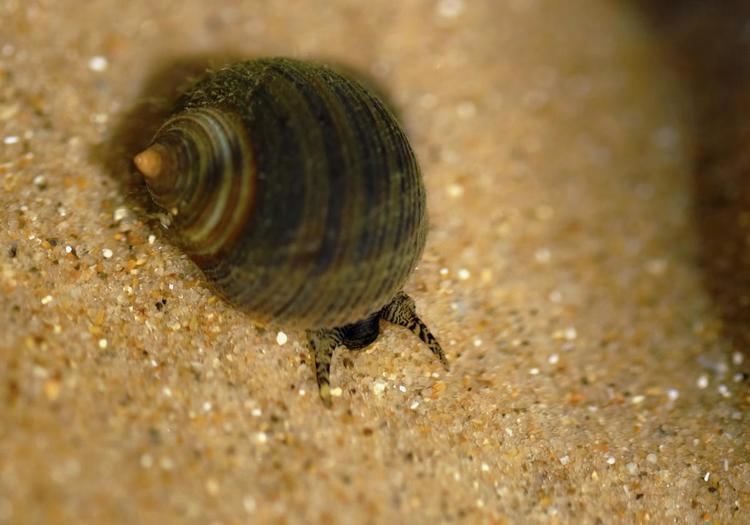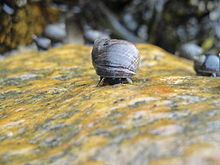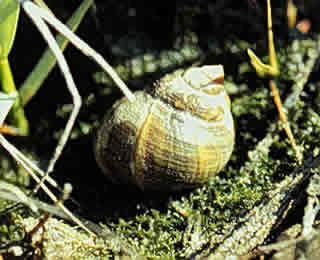Superfamily Littorinoidea Genus Littorina Higher classification Littorina | ||
 | ||
Similar Littorina, Buccinum undatum, Littorinidae | ||
Littorina littorea linnaeus 1758 common periwinkle
The common periwinkle or winkle (Littorina littorea) is a species of small edible sea snail, a marine gastropod mollusc that has gills and an operculum, and is classified within the family Littorinidae, the periwinkles.
Contents
- Littorina littorea linnaeus 1758 common periwinkle
- Description
- Measuring
- Distribution
- Introductions to North America
- Habitat
- Zoning
- Feeding
- Life cycle
- Growth rate
- Parasites
- Mortality
- Human use
- Supply chain
- Fisher
- Processor
- Distributor
- Retail
- Methods to increase commercial value
- Aquaculture
- References
This is a robust intertidal species with a dark and sometimes banded shell. It is native to the rocky shores of the northeastern, and introduced to the northwestern, Atlantic Ocean.

There is another snail known as small periwinkle or Melarhaphe neritoides that looks similar, but is smaller in size.
Description

The shell is broadly ovate, thick, and sharply pointed except when eroded. The shell contains six to seven whorls with some fine threads and wrinkles. The color is variable from grayish to gray-brown, often with dark spiral bands. The base of the columella is white. The shell lacks an umbilicus. The white outer lip is sometimes checkered with brown patches. The inside of the shell has a chocolate-brown color.
The width of the shell ranges from 10 to 12 mm at maturity, with an average length of 16–38 mm.
Shell height can reach up to 30 mm, 43 mm or 52 mm.

As a result of its robust nature, Littorina littorea can be highly variable in phenotype with several different morphs present. Its phenotypic variations may be indicative of a speciation event, as opposed to phenotypic plasticity. This is of particular importance to evolutionary biology, as it presents the possible opportunity to view a transitional phase in the evolutionary life of an organism.
Measuring
Measuring the shell from the end of the aperture to the apex reveals the length of the snail. Turning the shell over with the aperture flat on a surface and measuring vertically reveals the height of the snail. These measurements can be done using a caliper.
Distribution
Common periwinkles are native to the northeastern coasts of the Atlantic Ocean, including northern Spain, France, England, Scotland, Ireland, Scandinavia, and Russia.
There have been more than 14 000 observations made available as a dataset at the Global Biodiversity Information Facility - Littorina Littorea, which can be explored. More distribution information can also be found at Ocean Biographic Information System - Littorina Littorea. The NBN Gateway - Littorina Littorea has a good distribution map over the UK and Ireland. The datasets may be overlapping.
Introductions to North America
Common periwinkles have been introduced to the Atlantic coast of North America, possibly by rock ballast in the mid-19th century. This species is also found on the west coast of the United States, from Washington to California. The first recorded sighting in the East was in 1840 in the Gulf of St. Lawrence. It is now abundant on rocky shores from New Jersey northward to Newfoundland. In Canada, its range includes New Brunswick, Nova Scotia, Quebec, Newfoundland and Labrador.
L. littorea is now the most common marine snail along the North Atlantic coast. It has changed North Atlantic intertidal ecosystems via grazing activities, altering the distribution and abundance of algae on rocky shores and converting soft-sediment habitats to hard substrates, as well as competitively displacing native species.
Habitat
The common periwinkle is mainly found on rocky shores in the higher and middle intertidal zone. It sometimes lives in small tide pools. It may also be found in muddy habitats such as estuaries, and can reach depths of 180 feet. When exposed to either extreme cold or heat while climbing, a periwinkle will withdraw into its shell and start rolling, hoping to hit the water.
Zoning
The movement both horizontally and vertically according to light and dark as well as temperatures have been observed, but over a short timespan, the movement seems to be random.
Experiments seem to indicated that the snail responds to light and current, and moves accordingly.
Feeding
L. littorea is an omnivorous, grazing intertidal gastropod. It is primarily an algae grazer, but it will feed on small invertebrates such as barnacle larvae. It uses its radula to scrape algae from rocks and, in the salt marsh community, pick up algae from cord grass or from the biofilm that covers the surface of mud in estuaries or bays. Macroalgaes which can be happily consumed include Ulva lactuca and Ulva intestinalis, but if provided, also blue mussel seems to be consumed.
The radula is taenioglossate, consisting of seven teeths per row: one middle tooth, flanked on each side by one lateral and two marginal teeth. The radula is used as a 'rake', to scrape algae and detritus.
Phlorotannins in the brown algae Fucus vesiculosus and Ascophyllum nodosum act as chemical defenses against L. littorea.
Life cycle
L. littorea is oviparous, reproducing annually with internal fertilization of egg capsules that are then shed directly into the sea, leading to a planktotrophic larval development time of four to seven weeks. Females lay 10,000 to 100,000 eggs contained in a corneous capsule from which pelagic larvae escape and eventually settle to the bottom. This species can breed year round depending on the local climate. Benson suggests that it reaches maturity at 10 mm, and normally lives five to ten years. while Moore suggests that maturity is reached in 18 months. Some specimens have been seen reaching an age of 20 years.
Female specimens have been observed to be ripe from February until end of May, when most are spawning. Male specimens are mainly ripe from January until end of May, and lost weight after copulation. The settlement of the young seems to happen primarily in the period end of May to end of June, but other sources indicate earlier settlement.
Growth rate
A study in Plymouth Sound suggests an initial growth reaching up to 14 mm in height December the first year, and 17.4 mm by the end of the second year. H.B. Moore notes the dangers of drawing conclusions on looking at a population from a limited location over a short time period. Females seem to grow more rapid than males, and in specimens above 25 mm in height, females seem to dominate. Another study undertaken in Blackwater Estuary, Essex by F.S. Wright shows growth reaching up to 8 mm the first winter.
Parasites
The common periwinkle can act as a host for various parasites, including Renicola roscovita, Cryptocotyle lingua, Microphallus pygmaeus and Himasthla sp.. More studies are needed before any conclusions regarding stunting, no effect or enhanced growth rate due to parasites can be reached. It seems that growth rate is primarily affected on available food and time available for feeding, and not parasites.
Polydora ciliata has also been found to excavate burrows in the shell of the common periwinkle when the snail is mature (above 10 mm long). The reason why this only happens to mature snails are not yet known, but one hypothesis is that a mature snail will excrete a signal substance which attracts the Polydora ciliata larvae, while another hypothesis is that a mature snail has a change in the shell surface, which makes it suitable for Polydora ciliata larvae to settle. The infection by this parasite does not seem to alter the growth and proportions of the snail shell.
Mortality
Mortality rate of up to 94% per annum has been observed for the first two months, followed by up to 60% per annum for the rest of the first year. Older individuals above 15 months old seem to only have a mortality of 23% per annum. Cercaria emasculans is known to be fatal to the snail, but this does not account for the observed mortality.
Human use
This species appears in prehistoric shellfish middens throughout Europe, and is believed to have been an important source of food since at least 7500 B.C.E. in Scotland. It is still collected in huge quantities in Scotland, mostly for export to the Continent, and also consumed locally. The official landings figures for Scotland indicate over 2,000 tonnes of winkles are exported annually. This makes winkles the sixth most important shellfish harvested in Scotland in terms of tonnage, and seventh most important in terms of value. However, since actual harvests are probably twice reported levels, the species may actually be the fourth and sixth most important, respectively.
They are usually picked off the rocks by hand or caught in a drag from a boat. They are mostly eaten in the coastal areas of Scotland, England, Wales and Ireland, where they are commonly referred to as winkles or in some areas buckies, willicks, or wilks. In Belgium, they are commonly called kreukels or caracoles. They are commonly sold in paper bags near beaches in Ireland and Scotland, boiled in their local seawater, with a pin attached to the bag to enable the extraction of the soft parts from the shell.
Periwinkles are considered a delicacy in African and Asian cuisines. The meat is high in protein, omega-3 fatty acids and low in fat; according to the USDA National Nutrient Database for Standard Reference, raw snails in general are about 80% water, 15% protein, and 1.4% fat.
Periwinkles are also used as bait for catching small fish. The shell is usually crushed and the soft parts extracted and put on a hook.
Following their history as an ancient food source in Atlantic Europe, they are harvested and consumed in the Azores Islands by the Portuguese people, usually called búzios, the generic name for sea snails.
Similar foods are consumed by other maritime cultures throughout the world, such as the Chinese people. Periwinkles, or a similar species, are sold at the live seafood counter in the Chinese-Canadian grocery chain, T&T Supermarket.
The record for the furthest a human has spat a winkle was 10.4 metres by Alain Jourden (France) in 2006.
Supply chain
As for seafood supply chains in general, the supply chain consists of a fisher, processor, distribution and finally the retailer. The true nature of the supply chain is usually more complex and opaque, with the potential for periwinkle harvesting areas and date of catch to be changed.
Fisher
Commonly harvested in buckets by fishers walking in the intertidal zone on low tide, other methods have been tried.
In Maine, using a dredge tool towed from a vessel is common practice.
In Norway, using snorkeling have also been observed.
A report on the state of the periwinkle industry in Ireland suggests a minimum catch size in order to preserve the population.
Processor
The processor buys in bulk from the fisher, involving a possibly long transport route by land in a refrigerator truck or airplane, taking care to avoid temperatures below 0° Celsius.
Having fresh seawater readily available, the periwinkles are first graded if possible, using a machine custom built for the purpose. The method used for grading differs, but two proven methods include a Trommel screen with horizontal bars instead of a mesh, and a circle-throw vibrating machine also using bars. The price to purchase a complete sorting machine can be 10 000 EUR and upwards.
Periwinkles are graded by number of snails per kilogram. The following table displays some common grades in France, and the value they commonly fetch from the fisher, delivered. The actual value is depending upon supply and demand, with seasonal variations. The actual ranges may also differ from each establishment.
After grading, the periwinkles are "climbed" close to the end consumer, a term used to describe the act of checking if they are still alive. This can take anywhere from a few hours to several days, depending on how virile the periwinkles are, and the temperature of the water they climb in. Any periwinkles left immobile at the bottom are considered dead, and is waste. It is not uncommon to have up to 8% waste in a shipment.
Hereafter, the winkles are commonly packed in smaller quantities, before being distributed to customers. Mesh bags from 3 to 10 kg are common.
Distributor
In order to sell large quantities, distributors are commonly used in order to move the periwinkles to the retailer. These have vast networks of transport available both internationally, regionally and locally inside a city. In order to move periwinkles all the way, one would usually depend upon several distributors, each focusing on their own part of the transport network.
Retail
The Common Periwinkle is sold by fishmongers at seafood markets in large cities around the world, and is also commonly found in seafood restaurants as an appetizer or as a part of a seafood platter. In some countries, the pubs usually also serve periwinkles as a snack well served with a cold beer.
Most of the volume is consumed by France, Belgium, Spain and the Netherlands.
Methods to increase commercial value
Ongrowing has been investigated as a potential way of increasing commercial value, but no documented pilot facilities have been established. By harvesting the periwinkle during the summer, and storing them with feed until December, not only should the grade have been increased, but the market value should be higher since supply is lower in the cold winter months.
Aquaculture
Raising the common periwinkle has not been a focus due to its abundance in nature and relatively low price, however there are potential benefits from aquaculturing this species, including a more controlled environment, easier harvesting, less damages from predators, as well as saving the natural population from commercial harvesting.
